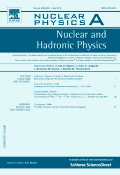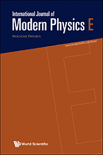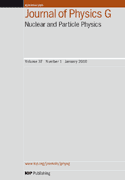
Journal of Condensed Matter Nuclear Science
Scope & Guideline
Exploring the Frontiers of Nuclear Science and Condensed Matter.
Introduction
Aims and Scopes
- Low-Energy Nuclear Reactions (LENR):
The journal predominantly publishes research on LENR, examining the mechanisms, conditions, and implications of these reactions in various materials, particularly metals like palladium and nickel. - Experimental Techniques and Methodologies:
A significant focus is placed on innovative experimental approaches to study LENR phenomena. This includes calorimetry, spectroscopy, and advanced detection techniques to validate and quantify nuclear reactions. - Theoretical Modelling and Frameworks:
The journal emphasizes the development of theoretical models that explain the observed phenomena in LENR, including phonon-mediated interactions and exotic vacuum objects. - Interdisciplinary Approaches:
Research published in the journal often integrates concepts from physics, chemistry, and materials science, reflecting a multidisciplinary approach to understanding condensed matter nuclear science. - Energy Generation and Applications:
There is a consistent interest in the potential applications of LENR for energy generation, including discussions on energy conversion technologies and their feasibility in practical scenarios.
Trending and Emerging
- Nanomaterials and LENR:
Recent studies have highlighted the role of nanostructured materials in facilitating LENR, emphasizing their unique properties and interactions with hydrogen and deuterium, which may enhance reaction rates and efficiency. - Quantum and Phonon Interactions:
There has been a growing interest in understanding the quantum mechanical aspects and phonon interactions involved in LENR processes, suggesting a deeper exploration of the fundamental physics underlying these reactions. - Energy Harvesting Technologies:
Research into practical energy generation methods using LENR has gained traction, with studies focusing on innovative energy converters and their applications in sustainable energy solutions. - Biological and Environmental Impacts of LENR:
Emerging research is beginning to explore the implications of LENR on biological systems and the environment, which could lead to novel applications or concerns related to LENR technologies. - Interdisciplinary Collaborations:
Collaborative research that integrates insights from various scientific disciplines is on the rise, indicating a trend towards a more holistic understanding of LENR and its applications.
Declining or Waning
- Negative Experimental Results:
Research articles discussing negative LENR results or failures have become less frequent, suggesting a possible shift away from scrutinizing unproductive avenues in favor of more promising experimental setups. - Traditional Nuclear Physics Comparisons:
Comparative studies between LENR and traditional high-energy nuclear physics have decreased, indicating a move towards more specialized investigations that focus solely on the unique aspects of LENR. - Historical Perspectives on LENR:
Papers reviewing the historical context or controversies surrounding LENR, such as those addressing pseudoscience claims, have diminished, possibly as the field matures and seeks to establish a more scientifically rigorous identity.
Similar Journals

Problems of Atomic Science and Technology
Advancing the Frontiers of Atomic Science.Problems of Atomic Science and Technology is a leading journal in the realm of nuclear physics and technology, published by the esteemed Kharkov Institute of Physics and Technology. With an ISSN of 1562-6016, this journal is dedicated to disseminating high-quality research and advancements in atomic sciences, contributing significantly to both academic and practical applications in the field. Although not an open access publication, it ensures rigorous peer review standards to maintain the integrity and relevance of cited works. The journal seeks to provide a vital platform for researchers, professionals, and students who are engaged in the exploration of atomic phenomena, nuclear engineering, and associated technologies. Published from Kharkov, Ukraine, the journal also serves as a bridge for international collaboration and innovation, making it indispensable for anyone looking to stay at the forefront of atomic science research.

Condensed Matter Physics
Inspiring Future Discoveries in Condensed MatterCondensed Matter Physics is a prestigious open-access journal published by the Institute of Condensed Matter Physics, National Academy of Sciences Ukraine. Since its inception in 1993, this journal has been dedicated to the dissemination of high-quality research in the field of condensed matter physics, providing a platform for scientists worldwide to share their latest findings. With an ISSN of 1607-324X and an E-ISSN of 2224-9079, it caters to a diverse audience, including researchers, professionals, and students. Although classified in the Q4 quartile for both condensed matter physics and miscellaneous physics and astronomy category, the journal plays a vital role in fostering communication among experts and advancing knowledge in this dynamic field. It is particularly vital for emerging researchers as it supports open access, ensuring that critical research is available to all, removing barriers to information. The journal's relevance remains steadfast, covering a wide array of topics and encouraging interdisciplinary approaches, and it is poised to inspire future scientific explorations until at least 2024.

NUCLEAR PHYSICS A
Connecting Theory and Practice in Nuclear PhysicsNUCLEAR PHYSICS A, published by Elsevier, is a leading international journal dedicated to the fields of Nuclear and High Energy Physics. With an ISSN of 0375-9474 and E-ISSN 1873-1554, the journal has been pivotal in advancing research since its inception in 1967 and is set to continue influencing the discipline through 2025. It holds a commendable Q2 classification in the 2023 category of Nuclear and High Energy Physics, ranking 32nd out of 87 journals in its field according to Scopus, placing it in the 63rd percentile. NUCLEAR PHYSICS A provides valuable insights and disseminates cutting-edge research, aiding researchers, professionals, and students in their academic and practical pursuits. Though it does not currently offer open access, the journal remains a vital resource for those engaged in the exploration of nuclear phenomena and theoretical advancements in high-energy physics.

Condensed Matter
Illuminating the Path of Condensed Matter StudiesCondensed Matter is a leading open-access journal dedicated to the diverse and dynamic field of condensed matter physics, published by MDPI since 2016. With its base in Switzerland, the journal aims to present a platform for researchers and professionals to share innovative findings and advancements in areas such as electronic, optical, and magnetic materials. As of 2023, it is ranked in the Q3 category for both condensed matter physics and electronic, optical, and magnetic materials, a testament to its relevance and growth within the scientific community. Researchers will find valuable insights through its accessible format, fostering collaboration and knowledge dissemination within this interdisciplinary field. With a commitment to enhancing the global dialogue in condensed matter studies, Condensed Matter invites contributions that explore theoretical and experimental approaches, thus pushing the boundaries of understanding in this crucial area of science.

Radiation Detection Technology and Methods
Transforming Nuclear Science Through Innovative ResearchRadiation Detection Technology and Methods is a prominent academic journal published by Springer Singapore Pte Ltd, dedicated to advancing the field of nuclear and high-energy physics, as well as nuclear energy and engineering. Established in 2017, this journal provides a platform for the dissemination of pioneering research and innovative methodologies in radiation detection technology. As of 2023, it holds a commendable Q2 ranking in both the categories of Nuclear and High Energy Physics and Nuclear Energy and Engineering, underscoring its significance in fostering scholarly discourse within these vital fields. With ISSN 2509-9930 and E-ISSN 2509-9949, the journal aims to cater to a diverse audience of researchers, professionals, and students, emphasizing open access to knowledge. The journal's contributions are particularly crucial for those engaged in the development of safer and more efficient radiation detection techniques, ultimately bridging the gap between theory and practical applications in energy security and health physics. For researchers seeking a dedicated outlet for their work, Radiation Detection Technology and Methods represents an invaluable resource and an opportunity to influence the future of radiation science.

INTERNATIONAL JOURNAL OF MODERN PHYSICS E
Fostering Global Collaboration in Physics and AstronomyThe INTERNATIONAL JOURNAL OF MODERN PHYSICS E, published by WORLD SCIENTIFIC PUBL CO PTE LTD, serves as a distinctive platform for the dissemination of high-quality research in the fields of Nuclear and High Energy Physics, as well as Physics and Astronomy. With an ISSN of 0218-3013 and covering a timeline from 1996 to 2024, the journal has established itself within the academic community, achieving a respectable Q3 ranking in its respective categories for 2023, underscoring its commitment to advancing knowledge in modern physics. Although it operates without an open access model, the journal's curated content is accessible to a wide audience of researchers, professionals, and students engaged in cutting-edge physics. Set in Singapore, this journal not only contributes to scholarly discussions but also fosters a global collaboration among physicists, making it an invaluable resource for those seeking to deepen their understanding and contribute to ongoing dialogues in the scientific community.

INSTRUMENTS AND EXPERIMENTAL TECHNIQUES
Advancing the Frontiers of Instrumentation and ExperimentationINSTRUMENTS AND EXPERIMENTAL TECHNIQUES is a renowned academic journal dedicated to the field of instrumentation and experimental methodologies within physics and engineering. Published by MAIK NAUKA/INTERPERIODICA/SPRINGER, this journal serves as a vital platform for disseminating innovative research findings, detailed experimental techniques, and advancements in instrumentation technologies. Operating since its inception in 1968, it has established itself as a reputable source for scholars and industry professionals, though it currently holds a category quartile ranking of Q4 in Instrumentation based on the 2023 metrics. With an ISSN of 0020-4412 for print and E-ISSN of 1608-3180 for electronic formats, the journal is accessible to a global audience, offering crucial insights that can lead to significant advancements in experimental approaches across various scientific domains. Despite a current Scopus ranking placing it in the lower percentile, the journal continues to contribute to the ongoing discussions and developments in instrumentation, making it an essential read for researchers, professionals, and students eager to enhance their knowledge and expertise in this specialized area.

JOURNAL OF PHYSICS G-NUCLEAR AND PARTICLE PHYSICS
Unveiling the Mysteries of the Subatomic WorldJOURNAL OF PHYSICS G-NUCLEAR AND PARTICLE PHYSICS, published by IOP Publishing Ltd, stands as a premier journal in the realm of Nuclear and High Energy Physics. With an established presence since 1989 and currently converging toward 2024, this influential journal emphasizes groundbreaking research and discoveries in particle physics, fostering the dissemination of knowledge among a global audience of researchers, professionals, and students. Recognized for its high-quality publications, it holds a Q1 ranking in its category for 2023, placing it at an impressive 87th percentile among 87 journals in its field as per Scopus Rankings. The journal's impact is reflected in its esteemed reputation, making it an essential resource for advancing the frontiers of physics. Although it currently does not operate under an open access model, the journal ensures that subscribers receive comprehensive insights into the latest developments and theoretical advances that shape our understanding of the universe.

JOURNAL OF MAGNETIC RESONANCE
Connecting Science through Magnetic Resonance DiscoveriesThe JOURNAL OF MAGNETIC RESONANCE, a leading peer-reviewed publication from ACADEMIC PRESS INC ELSEVIER SCIENCE, serves as a vital platform for disseminating cutting-edge research in the fields of biochemistry, biophysics, and condensed matter physics. With an ISSN of 1090-7807 and an E-ISSN of 1096-0856, this journal is committed to publishing innovative studies that explore the principles and applications of magnetic resonance techniques. Ranking in the Q3 and Q2 quartiles across various categories in 2023, it reflects a robust standing within the academic community, especially noted for its contributions to nuclear and high energy physics where it ranks 29th out of 87 journals. The journal's comprehensive scope and emphasis on accessible research make it an essential resource for researchers, professionals, and students alike, facilitating advancements in both theoretical and practical aspects of magnetic resonance. With conversion years spanning 1997 to 2024, the journal continues to uphold its legacy as a cornerstone of knowledge in the best practices of scientific research.

Physics of Particles and Nuclei Letters
Connecting Theory with Practical Applications in PhysicsPhysics of Particles and Nuclei Letters, published by PLEIADES PUBLISHING INC, serves as a pivotal platform for the dissemination of cutting-edge research in the domains of particle and nuclear physics. With an ISSN of 1547-4771 and an E-ISSN of 1531-8567, this journal has been actively contributing to the scientific community since its inception in 2006 and continues to be influential, with a convergence period extending to 2024. While its open access options are limited, the journal is recognized for its rigorous peer-review process and commitment to quality, as reflected in its Scopus rankings across multiple categories, including a Q3 in Nuclear and High Energy Physics and Radiation in 2023. The journal is positioned to be a vital resource for researchers aiming to bridge theoretical understanding with practical applications in these highly specialized fields, fostering advances that resonate within atomic and molecular physics, radiology, and beyond. Its relevance continues to grow as the global scientific community seeks innovative solutions to complex problems in modern physics.